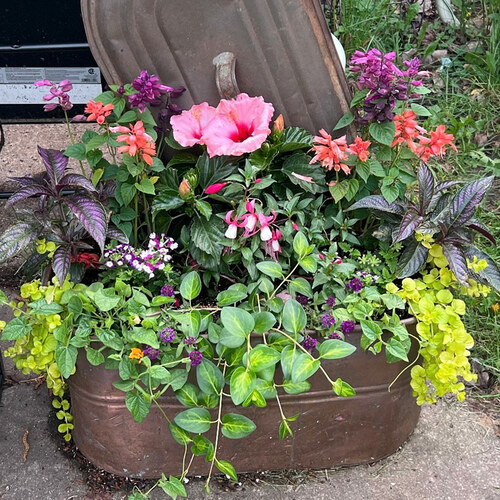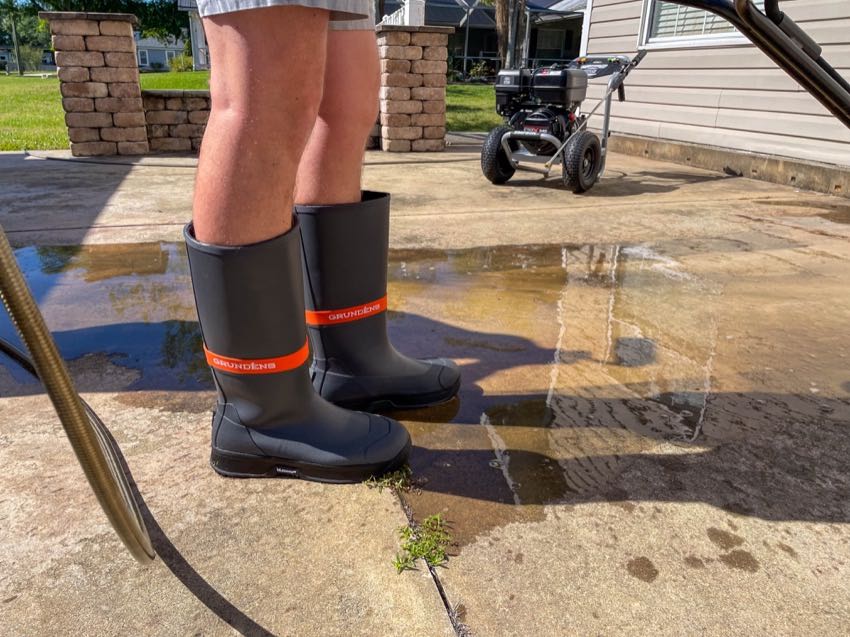
A view of the South Dakota Badlands and prairielands / Rebecca Latson
In 1988, I moved from Kentucky to Washington state. My parents decided to help me and we made it a combination move and sightseeing road trip. Along the way, we stopped at the Mitchell Corn Palace and Wall Drug, both in South Dakota. I distinctly remember turning my head to view the distant formations of Badlands National Park as we drove west toward Wall. The Pinnacles Entrance was only eight miles south of Wall and I’d really wanted to take the exit and drive the road through the park. To keep to our schedule, though, I needed to stick to Mom & Dad’s itinerary since a complete drive-through of the park’s Loop Road would have taken at least two hours out of the day. I made a mental note to someday return.
Fast forward to April 2024, some 36 years later. Packed not quite to the gills, my Toyota 4Runner and I traveled two days’ east along Interstate 90 through Washington, Idaho, Montana, and Wyoming into South Dakota toward Badlands.
Now, one could be forgiven for thinking this is a national park you can see in an hour or so then move on along to the next big thing, because you can see so much from the road. To really get a feel for Badlands, however, you should spend at least a couple of days, if not more. This is especially true if you are a photographer loaded (to the gills) with cameras and gear.
My park arrival coincided with the noon hour, which meant harsh overhead light and a washed-out look to the formations. The air quality was such that haze settled over the landscape. No matter. Photographers make do with whatever light is given them.

A first view of the badlands just off Sage Creek Rim Road, Badlands National Park / Rebecca Latson
If you encounter a situation like this at Badlands (or any national park, really) you can mitigate some of that haze and washed-out look due to the overhead sun with a circular polarizing filter (CPL). Judicious use of whatever “dehaze” slider your photo editing software provides also works quite well.
Here’s somethingelse to think about, too. During the height of the day, when the light is harsh and bright, there are no shadows for depth, and the colors of the landscape look washed out, think about returning during another time of day. The photo below was taken not too long after the photo above, so everything looked bright and washed out.

Ancient Hunters Overlook shortly after noontime, Badlands National Park / Rebecca Latson
I returned to this spot during sunset and the colors and light were much more saturated.

Sunset at Ancient Hunters Overlook, Badlands National Park / Rebecca Latson
There are numerous overlooks along the park road. You should stop at each one of them, read the informational signs, and figure out whether this might be an area you want to photograph during the “golden hours” of sunrise or sunset. Some of these view areas are situated just right for capturing both sunrise and sunset (e.g Burns Basin Overlook).

Sunrise at White River Valley Overlook, Badlands National Park / Rebecca Latson
The sunrise image above was photographed at the White River Valley Overlook. I almost didn’t even get this shot! I was so tired from my arrival the previous day that I overslept (for a photographer trying to get a sunrise photo, oversleeping usually means waking up at 4 or 5 a.m. instead of 2 a.m.). Figuring I’d probably missed a sunrise opportunity, I nonetheless started my photographic day. Fat chance I’d get any sunrise at all, since it looked cloudy outside.
Hah! Turning the corner near this overlook, I saw hints of colorful sunlight paint the sky above the horizon and made the snap decision to park, grab tripod and camera, and quickly trot to a spot to capture whatever I could of the sunrise. This light only lasted a minute before the clouds hid the sun, but it was the start to a great photographic day.

A hesitant start to the morning over Norbeck Pass, Badlands National Park / Rebecca Latson

Early morning at Burns Basin Overlook, Badlands National Park / Rebecca Latson
Speaking of clouds, a springtime visit will ensure you see clouds at least one day out of your stay. Clouds are a photographer’s best friend, adding character and drama to a scene. As a matter of fact, many photographers abhor a clear, sunny, bluebird kind of day because they feel the sky and light are too monotonous. I don’t agree with that opinion, but photography is a subjective art.

Badlands bison, Badlands National Park / Rebecca Latson

Scolding the photographer, Badlands National Park / Rebecca Latson
As you drive around, keep your telephoto lens or setting ready for wildlife. The bison I saw tended to stay near the park’s Pinnacles Entrance. On the other hand, prairie dogs were all over the park. Prairie dog “towns” are easy to spot at Badlands. Just look for dark-colored, bare ground with lighter, beige mounds dotting the dark ground. Those are entrances and exits to an extensive network of tunnels sloping down 10 feet and providing safety and homes for not only these pipsqueaks of the squirrel family, but also snakes, worms, and insects.

A prairie dog at a prairie dog town, Badlands National Park / Rebecca Latson
Get out and just stand there with your tripod and camera (they will eventually get used to your presence if you don’t move), or stick your long lens out your vehicle’s open window to capture shots of these funny little guys. The longer you remain there, the more interesting behavior you’ll see (and photograph).
It also goes without saying (I’ll say it anyway) that you should never feed the prairie dogs or other wildlife. It’s not good for their digestive systems, it makes them dependent upon human food, and they can get aggressive when they see/smell something they want to eat.
Hey, even if you can’t get a decent close-up shot of the wildlife with your telephoto lens or setting, go on ahead and capture the shot. Including wildlife in your landscape shots give your viewers an idea of the environment in which that wildlife lives and roams.

Bighorn ram in the prairie grass wearing quite the fancy collar, Badlands National Park / Rebecca Latson
Badlands is not just about the rock formations This national park encompasses a broad swath of mixed-grass prairie, best viewed at Prairie Wind Overlook. This is a great place to stop and just watch the wind blowing through that grass “ocean” while listening to birdsong.
To capture and give scale to something this vast and uniform, it helps to have a point of reference, such as this boardwalk leading to the benches at Prairie Wind Overlook. I know – a human-made object in a landscape shot is considered practically anathema by many photographers. Depending upon how you compose the shot, adding evidence of civilization provides not only reference, but a break in the otherwise non-measurable uniformity of a scene like the ocean of prairieland grass at this view area. Human-made objects also provide scale to these vast Badlands landscapes.

A vast “ocean” of mixed-grass prairie, Badlands National Park / Rebecca Latson

Prairie Wind Overlook, Badlands National Park / Rebecca Latson
Get some shots of those overlook areas (including the human-made stuff). Many viewers like seeing the positioning of an overlook as well as to the feature(s) to which it points.

The view at Pinnacles Overlook, Badlands National Park / Rebecca Latson
Get some leading line shots using roads or trails. Leading lines take the viewer’s eyes from one part of the image to another. If you photograph a road leading line, please do remember to check both ways first before heading out into the middle of the pavement.

The leading line of the Window Trail, Badlands National Park / Rebecca Latson
Don’t forget to photograph those little things you see (like this in situ fossil dung beetle ball). It’s those little things that flesh out the Big Picture of a national park.

An in situ (in place) fossil dung beetle ball about 1/2-inch in diameter and around 30-32 million years old, Badlands National Park / Rebecca Latson
Photograph anything that interests you and that might be used for any educational/informational/documentation purposes. I do this for posting on the Traveler’s Facebook and Instagram sites (Trivia Tuesday and Fun Fact Friday). I also use them for the quiz and trivia pieces I write for the Traveler. Get a photo, learn about what you’ve photographed, and impress family, friends, and colleagues with your knowledge of that photo’s subject. Knowledge is power!
Badlands is awesome for starry skies, with almost no light pollution … unless you happen to visit during a full moon. If that’s the case, make use of that moon and moonlight. I didn’t get any starry sky shots, but the moon over the badlands formations was absolutely astounding. It was so bright that I could practically read from it … ok, maybe not, but it was bright.

A full moon and sunset alpenglow at Panorama Point, Badlands National Park / Rebecca Latson

Moonlight over Big Foot Pass, Badlands National Park / Rebecca Latson
On another night, the moon was red-orange! Seriously!

A telephoto shot of the full moon over the Castle Trail landscape, Badlands National Park / Rebecca Latson
You really should use a tripod for starry sky / moonlight imagery. To capture as much natural light as possible for the shot, you’ll need a wide-open aperture (aka f-stop of 1.5 to 4) and a slow shutter speed (5, 10, 25+ seconds). A tripod prevents camera blur, which is especially important in this national park, where the wind can feel like it’s blowing at hurricane levels while attempting to stand still enough to handhold your camera. Even better is to use a remote shutter release or your camera’s two-second delay timer, thus reducing vibration from your finger pressing down on the shutter button.
Let’s get back to sunrise and sunset shots for a moment. That sunrise photo earlier in the article was facing east toward the sun. Sometimes, though, an eastern sunrise might be blah, yet produce astounding light over the badlands formations looking toward the west.

Sunrise over the landscape at Burns Basin Overlook, Badlands National Park / Rebecca Latson
Same thing for sunset. When I captured the golden light upon the landscape at Burns Basin Overlook, the sun itself was harsh and a bit hazy in the west, so rather than focus on trying to get a sunstar-type setting sun shot of the sun, I concentrated on the golden sunlight bathing portions of the formations from that setting sun.
I stayed past sunset to photograph the “blue hour” at this overlook. Blue hour doesn’t really last an hour, just like the sunrise or sunset “golden hours” doesn’t last an actual hour. So, you want to make sure your camera setup is in place at least 30 minutes prior to sunrise or sunset to capture a landscape bathed with blues, pinks, purples, and mauves. You might even capture the atmospheric phenomenon known as the “belt of Venus.”

A full moon and the belt of Venus during blue hour at Burns Basin Overlook, Badlands National Park / Rebecca Latson
Good things come to those who wait. Thirty-six years of waiting to visit Badlands National Park meant a great stay with great photos for me. You, however, shouldn’t wait as long as I did. Get out there with your cameras sooner rather than later to capture aspects of this landscape the Lakota people dubbed “mako sica” (bad lands). These “bad lands” produce great landscapes.

Conata Basin Overlook, Badlands National Park / Rebecca Latson





